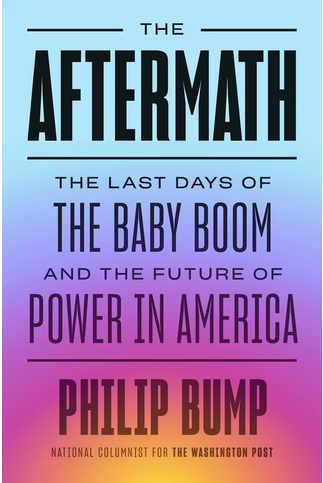
Philip Bump explores the impact of this huge, and hugely influential, generation in ‘The Aftermath’
No one can accuse Bump of sparing any details (and he certainly has not held back on the charts, which show up in abundance and which I found quite useful — in true millennial fashion, I snapped photos of several of them, and I plan to upload them to Instagram as soon as this review is published). As baby boomers enter the last few decades of their lives, a generation as influential as theirs deserves a retrospective this comprehensive.
To give readers a visceral sense of just how influential boomers have been, Bump borrows an analogy from other chroniclers of this most infamous of American generations: When the boomers entered the world, it was like “a python swallowing a pig.” From tip to tail, boomers changed everything: When they were born, “America unhinged its jaw, for better and worse,” Bump writes, “and the pig began to move through the system.”
 Boomer babies fueled a huge spike in diaper sales. American school systems had to rapidly expand classrooms and hire an enormous number of new teachers to make way for the influx of young boomer pupils. While baby boomers spent much of their lives benefiting from a robust economy, Bump observes that their very existence helped to create that prosperity: They were a cohort of historically unprecedented size, whose basic need to be clothed, fed, housed and educated was a decades-long jobs creator and economy stimulator. And they were a cohort whose massive size and timing — not just in the immediate aftermath of World War II, but decades into a postindustrial era of growth, government investment and a strong middle class — meant cultural and economic dominance for much of their lives. As teenagers, boomers saw their desires met by marketers who had only just discovered that teenagers with few obligations and a little disposable cash were a huge potential consumer group. Now, as older adults and retirees with waning obligations and a lot of disposable cash, boomers continue to hold a significant chunk of American wealth and the consumer power that goes with it — and in turn, products and services for boomers have proliferated, a trend that will no doubt continue as they enter their sunset years.
Boomer babies fueled a huge spike in diaper sales. American school systems had to rapidly expand classrooms and hire an enormous number of new teachers to make way for the influx of young boomer pupils. While baby boomers spent much of their lives benefiting from a robust economy, Bump observes that their very existence helped to create that prosperity: They were a cohort of historically unprecedented size, whose basic need to be clothed, fed, housed and educated was a decades-long jobs creator and economy stimulator. And they were a cohort whose massive size and timing — not just in the immediate aftermath of World War II, but decades into a postindustrial era of growth, government investment and a strong middle class — meant cultural and economic dominance for much of their lives. As teenagers, boomers saw their desires met by marketers who had only just discovered that teenagers with few obligations and a little disposable cash were a huge potential consumer group. Now, as older adults and retirees with waning obligations and a lot of disposable cash, boomers continue to hold a significant chunk of American wealth and the consumer power that goes with it — and in turn, products and services for boomers have proliferated, a trend that will no doubt continue as they enter their sunset years.
The government adjusted, too, smoothing boomers’ entrance into the world with significant investments in infrastructure and education, and now smoothing their exit with significant entitlement expenditures.
This is a book about generations — and in particular one mega-generation, the generation that created the concept of “generations” — but it’s also at heart a book about race, which Bump situates at the core of intergenerational discord.
The vast majority of boomers who were born in the United States were White, and that has shaped the generation’s politics. They have become a Browner generation because of immigration, but they remain far Whiter than millennials and Gen Zers (and yes, Whiter than the comparatively tiny Gen X, the oft-overlooked Jan Brady of the generation wars). The generation gap is in large part a racial gap, Bump argues, with White boomers hewing to a past cultural hegemony where, sure, their music and movies and tastes dominated, but where they also saw people who looked, lived and believed like them reflected almost universally in that music, those movies and the halls of power.
This is not all boomers, of course. But it is a lot of them. When you look at the data on boomers, conservatism and race, Bump writes: “Whichever direction the arrow points, it is generally the case that boomers are White and Whites are Republican and Republicans are often boomers. None of these statements is uniformly true, certainly, but the Venn diagram of the three has a lot of overlap.”
It is White anxiety, he argues, that animates boomer conservatism. And it’s this White anxiety and the conservatism it fuels that so often pit boomers against younger generations, which are more racially diverse and better-educated, which in turn makes the young — including the Whites among them — more liberal and forward-looking.
Now, as the age of boomer dominance wanes, one question Bump seeks to answer is: What next?
What will the country look like with boomers, who have had a stranglehold on American politics for the entirety of my almost 40 years on this planet, largely out of power? What happens when the now-largest adult generation — millennials — takes the reins? Millennials are demographically different from boomers in several major ways, including our racial identities, our religious views (or lack thereof) and where we live; at what point will American politics, policies and institutions change to reflect this new normal?
Bump is cautiously optimistic but clear-eyed about the weight of the work ahead. “What we can say with the most certainty is that the America into which the baby boomers were born is long gone and that the America they built is crumbling,” Bump writes. “The uncertainty is whether that America is replaced by ashes or, once again, a phoenix.”
In other words: What happens to the python after the pig moves through its system? Out of curiosity, I Googled. Disappointingly, the results of searching “What happens when a python swallows a pig” come from dubious sources, mostly YouTube videos with titles like “SNAKE ATE OUR PIG!” and “I FED MY SNAKE A PIG!!!!!!” But one story popped up from an only moderately disreputable source (the Daily Mail) that, despite the tabloid headline (“Reptile DEATH match”), seemed informative: X-rays of a Burmese python eating an alligator show the snake’s body undergoing rapid and pretty radical changes to accommodate the prey in its belly. “Each meal triggers dramatic increases in metabolism, upregulation of tissue function and tissue growth,” one scientist wrote in a summary of Burmese python digestive physiology. “Upon the completion of digestion, these postprandial responses are thrown into reverse; tissue function is collectively downregulated and tissues undergo atrophy.”
In short, the snake goes back to normal — unless he’s attacked by a predator while he sits largely immobile from his gluttony. But, most of the time, he winds up doing just fine.
.
Jill Filipovic is a journalist, a lawyer and the author of “OK Boomer, Let’s Talk: How My Generation Got Left Behind.”



